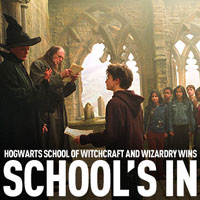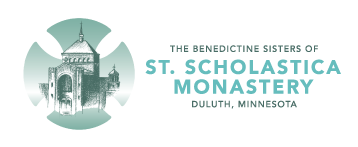The Wizarding World of Saints! is the theme for this year’s Homecoming Week at The College of St. Scholastica. Sister Edith adopted the Hogwarts theme for her Visum Monachae column in the student news paper, The Cable. Reprinted here with permission.
 Would you like to live in Harry Potter’s world?
Would you like to live in Harry Potter’s world?
Your first response, like mine, might be an enthusiastic “yes!” Who wouldn’t want to teleport to class, wave a wand to make a meal, or play a fascinating game like Quidditch? Yet our lives would still include office politics, housecleaning, and the difficulty of stretching a fixed income across a large family. Think of the Weasleys. Nonetheless, most Potter fans would risk the unknown to enter his world.
JK Rowling filled planet earth with strange plants and animals, a new physics, and some social practices unlike those we know. Imagine finding yourself “sorted” by a hat into one or another major on your first day at CSS. It fascinates us, in part, because the wizard’s world exists in the crevices of our everyday experience of life on Earth.
Academics began to study this new world using the tools of their disciplines. A professor at the Jepson Management School studied the leadership skills of Dumbledore and other characters. A Vanderbilt University psychologist compared development over the lifespan of wizards and humans. Honors students in the Science of Harry Potter seminar at Frostburg State University explored basic physical principals in the wizarding world. Dozens of courses include the Harry Potter novels in literature courses. Some schools offer theology and philosophy courses that explore the nature and interplay of good and evil in the novels.
Social issues abound in Harry Potter’s world. Wizards and muggles are both human. They inhabit the same physical world. Yet the impact of a single heritable trait segregates them into spheres with separate governance, laws, and justice systems. Interactions between the groups are marked by mistrust, tension, and dislike. Neither group wants greater contact with the other, nor imagines any possible benefit from it. This, too, has been a rich source for college courses.
The wizarding world is built on rivalry and competition, between houses and between students. Friendships serve as much to define outsiders as to benefit insiders. The students at Hogwarts, even more than muggle adolescents, struggle to find confidence and an identity when their performance is challenged and evaluated on all sides. Faculty are also uncertain of their status and divided in their loyalties. Some warm human bonds are seen, but they are not the central feature of wizard society.
Despite some similarities to the life he prescribed in his monasteries, St. Benedict would not be happy at Hogwarts. While he prescribes a strict schedule, promotes life in common, and emphasizes the importance of ritual, the key element of Benedictine spirituality is missing at Hogwarts. Without it, the similarity is superficial.
St. Benedict sees Christ in everyone he meets. The pilgrim, the sick, a recalcitrant monk, an artisan, a manager: each is an encounter with Christ. Service of others is the only class in his curriculum and the only competition allowed. Love overcomes rivalry. Rituals emphasize connection, not separation. Humans never quite succeed in Benedictine life, but their community’s love makes up the difference.
Benedict’s Rule teaches us how to live in God’s love. It is magic for muggles.
